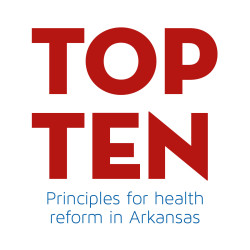
Act 96 of 2015 created the Health Care Reform Legislative Task Force in Arkansas. This task force will determine the future of the Private Option and the Medicaid program. The following principles should guide policymakers as they consider ways to transform and modernize the health care system. Policy changes should meet the health needs of all children and families.
Download the PDF: Top Ten Principles for Health Reform in AR.
Arkansas has made huge strides in covering kids. We need to protect and build on those gains. Moving forward, it’s important to maintain stable health care coverage, especially for low-income families. Medicaid serves more than 430,000 Arkansas children.[1] The ARKids First program has worked for Arkansas children since 1997. It has brought the rate of uninsured children in our state to record lows (6.5 percent in 2013). Because of this success, current program design and cost-sharing requirements should remain in place. We should also extend eligibility to migrant children who are here legally. To date, we have left these kids out of coverage.
Parents and caregivers should have access to affordable coverage. It helps them support the economic stability of the entire family. Children need healthy parents and covering parents also helps children stay covered. When whole families have access to coverage, we ensure our children can reach their full potential.
The state should increase primary care provider reimbursement rates in Medicaid. This would improve access to primary care services. Arkansas is among six states with a supply of primary care physicians lower than the national average.[2] A federal funding increase in primary care rates expired October 2014. Arkansas declined to maintain this rate increase. Yet, 15 other states have chosen to continue it using state funds.[3]
Arkansas should expand solutions that reward coordinated, high-quality care. In 2012, Arkansas launched the patient-centered medical home (PCMH) with Medicaid and private carriers. The goal of PCMH is to incentivize preventative care and proactive care management.[4] One practice that adopted PCMH early has had several successes. They reported a 44 percent reduction in hospital admissions and a 25 percent decrease in emergency rooms costs.[5] The state needs to expand this type of care coordination to people with complex conditions. Models like health homes would achieve this and include enhanced federal funding to get started.
Consumer outreach and education must be a priority as the health care system continues to change. The state must invest in outreach and education. It’s important to ensure consumers have the help they need to navigate the complex world of health insurance. This should include in-person assisters to inform consumers about their coverage options. It should also include resources to educate them on how to use coverage once they are enrolled.
Reforms should seek to ensure continuous, stable coverage for all Arkansans. Any proposals should ensure seamless coverage transitions and continuous access to coverage and care. Continuity of coverage is key to reform efforts. It should be a priority to prevent disruptions in coverage, like lockout periods in Medicaid. This could prevent enrollees from accessing critical care when they are unable to pay premiums and put them further behind in meeting their health care needs.
Changes should avoid adding red tape to an already complex health care system. The health care system is already difficult for even the most informed consumer to navigate. Added requirements or rules often result in more bureaucracy and higher administrative costs. For example, collecting small premiums in Medicaid makes the system more complex for consumers and administrators.
Benefits packages must be comprehensive enough to meet health care needs of consumers. Consumers should have access to a full continuum of health care services. Benefits must meet federal requirements like behavioral health treatment and dental service for kids. This should also include services that improve access, such as transportation to doctor’s appointments in Medicaid.
Consumers should have the right to choose and receive treatment in a variety of care settings. The state should enhance access to home and community-based treatment options for kids and adults who need higher levels of care. When appropriate, community-based treatment is typically more cost-effective than long-term facility-based care.
Reforms should address health disparities. Regardless of language, geographic region and culture, quality health care should be available to everyone. The state should identify strategies to address low provider capacity in rural areas and attract diverse health professionals statewide. Strategies may include telemedicine and school-based health centers. We should also regularly use data to report gaps and areas of progress.
[1] National Center for Health Statistics. Centers for Disease Control and Prevention. (2012). State Variability in Supply of Office-based Primary Care Providers: United States. Retrieved from: https://www.cdc.gov/nchs/data/databriefs/db151.htm
[2] https://kff.org/medicaid/perspective/the-aca-primary-care-increase-state-plans-for-sfy-2015/
[3] Arkansas Center for Health Improvement. Arkansas Health Care Payment Improvement Initiative (AHCPII). Retrieved from: https://www.achi.net/pages/OurWork/Project.aspx?ID=47.
[4] Arkansas Center for Health Improvement. (2015). Arkansas Health Care Payment Improvement Initiative: Statewide Tracking Report. Retrieved from: https://achi.net/Content/Documents/ResourceRenderer.ashx?ID=276.
[5] Arkansas Department of Human Services. Medicaid and ARKids First enrollment data. February 2015











You must be logged in to post a comment.